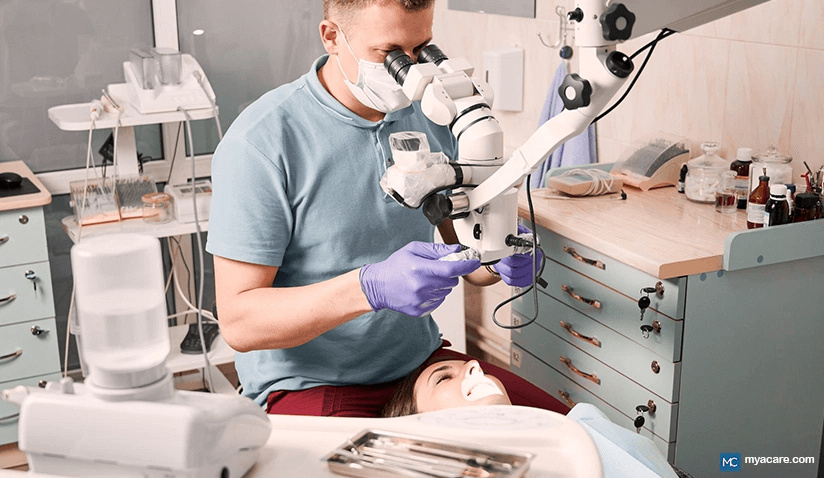How Does a Dentist Help Identify Head and Neck Cancers?

One is recommended to visit a general dentist every six months. These visits help check for the presence of cavities or gum-related problems. However, regular check-ups can also be useful in early detection of other life-threatening diseases such as cancers in the head and neck region.
In this article, we discuss different types of head and neck cancer and the role of dentists in the early detection of these cancers.
In the US, head and neck cancers contribute to ~4% of all cancers. These are more common in men over 50 years of age than women and younger adults. In 2021, over 68,000 people are estimated to develop head and neck cancers in the US. Among head and neck cancers, cancers in the mouth, throat, and voice box are most common. Early detection of head and neck cancer can help reduce cancer-related morbidity, since these cancers can become life-threatening if not treated early.
What are the different sites of head and neck cancers?
While cancers of the head and neck may start from any site (except the brain or eye), most cancers in the region originate in the mucosa (inner lining) of the mouth, throat, or voice box. Cancers involving salivary glands, sinuses, muscles, or nerves in the head and neck region are rare.
Below are the other sites where head and neck cancers can form:
- Inside the nose
- Within the sinuses (hollow spaces within the bones on the head and nose
- On the skin of the lips
- In the mouth, in the region of the tongue, gums, mucosa (or inner lining) of cheeks and lips, the floor of the mouth (region underneath the tongue), hard palate (top region of the mouth)
- In the saliva-producing glands. These are located in the floor of the mouth, under the tongue and along the inner lining of the mouth and throat
- In the voice box. Also known as larynx. It is present between the throat (pharynx) and windpipe (trachea)
- Within the throat. Also known as the pharynx. It has three parts: The upper part (nasopharynx), middle part (oropharynx), and lower part (hypopharynx)
What are the signs and symptoms that help the dentist identify cancers?
Below are some common signs and symptoms of cancer that dentists look for in different regions of the head and neck:
In the mouth
- White or red non-healing sore present on the gums, tongue, or inner lining of the mouth
- Swelling in the upper or lower jaws
- Uncommon bleeding of gums or other areas in the mouth
- Pain in the mouth
- Presence of lump or eroded areas on the tongue, or other areas in the mouth
- Difficulty moving tongue or jaw
- Chronic discomfort with dentures
Nose and sinuses
- Excessive bleeding through the nose
- Chronic headaches
- Chronic sinus infections
- Sinus infections that fail to respond to antibiotics
- Pain in the upper teeth
Voice box (larynx)
- Pain while swallowing or speaking
- Pain in the ears
- Presence of hoarseness in voice
- Presence of swelling in the neck
- Persistent pain in the neck
Throat (pharynx)
- Presence of lump or thickening in the throat or neck
- Persistent pain in the neck
- Difficulty while breathing or speaking
- Difficulty while swallowing or chewing food
- Chronic pain in the throat
- Persistent cough or sore throat
- Pain in the ears
Salivary glands
- Swelling around or underneath the chin
- Facial asymmetry due to the presence of swelling
- Numbness of facial muscles
- Continuous pain in the chin, face, or neck
What are the causes of head and neck cancers?
Below are some of the main reasons for cancer:
- Tobacco and alcohol: Intake of alcohol and tobacco in the form of cigarettes, cigars, pipes, betel quid, or snuff increases the risk of head and neck cancers. The deleterious chemicals present in these products damage the genetic makeup of cells in the mouth, leading to cancer. Intake of both tobacco and alcohol increases the risk of developing cancers
- Virus: Viruses such as human papillomavirus (HPV) are associated with throat cancer or oropharyngeal cancer. Infection with Epstein-Barr virus may lead to throat cancer
- Occupational hazards: Exposure to several carcinogens (cancer-producing agents) as a part of occupation increases the risk of cancer. For instance, exposure to wood dust is a risk factor for nasopharyngeal cancer, exposure to asbestos and synthetic fibers increase the risk of voice box cancer, and regular exposure to nickel dust or formaldehyde increases the risk of the nose and paranasal sinuses cancer
- Ultraviolet radiation: Excess exposure to sun or artificial ultraviolet radiations increase the risk of lip cancer
- Genetic disorders: The presence of genetic disorders (e.g., Fanconi anemia) increases the risk of cancer
How does a dentist help identify cancer at an early stage?
During a routine examination, the dentist will ask individuals about their medical, dental, and family history. He will further enquire if they are experiencing any new or unusual symptoms. In case the individual experiences ulcers, burning sensation or red and white areas in the mouth, tenderness or numbness in the mouth or lips, lump or thickening in the jaw or throat, sore throat, change in voice, or difficulty while swallowing for more than 2-3 weeks, then he/she should inform the dentist.
The dentist will carefully evaluate an individual's oral cavity including lips, cheeks, gums, the surface of the tongue, area below the tongue, and roof of the mouth. The dentist will then examine the throat, soft palate, tonsils, and back portion of the tongue.
Subsequently, the dentist will examine the jaws and neck for any swelling, lumps, or any other abnormalities.
If the dentist suspects anything unusual then he/she may refer the individual for further testing. Some dentists may conduct chairside screening tests for oral cancer or perform a biopsy and send it for investigation. The dentist may also refer the individual to a specialist for further examination.
How can an individual reduce the risk of head and neck cancer?
An individual can reduce the risk in the following ways:
- Quit smoking and consumption of tobacco
- Limit the consumption of alcohol
- Check with the doctor regarding the availability of the human papilloma vaccine. This can reduce the risk of viral infections and throat cancers. These vaccines are not recommended beyond 26 years of age. Older individuals may take the vaccine after consulting a doctor, as these vaccines are less effective in aging individuals
- Use lip balms containing sunscreens to reduce the exposure to UV radiation
- Limit the exposure to cancer-producing agents if you are regularly exposed to them due to occupational needs
- In case head and neck cancers run in the family, visit doctors regularly and undergo recommended tests
To search for the best Oncology healthcare providers in Germany, India, Malaysia, Singapore, Spain, Thailand, Turkey, Ukraine, the UAE, the UK and the USA, please use the Mya Care search engine.

Dr. Shilpy Bhandari is an experienced dental surgeon, with specialization in periodontics and implantology. She received her graduate and postgraduate education from Rajiv Gandhi University of Health Sciences in India. Besides her private practice, she enjoys writing on medical topics. She is also interested in evidence-based academic writing and has published several articles in international journals.
References:
Featured Blogs



